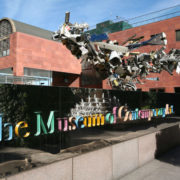Conversing with Conservators
Angelea Selleck
While I was a graduate student I had the opportunity to interview two conservators for a research project. After reading extensively about cases of botched restorations, I felt it was important to get the opinion of professionals in this field in order to gain a deeper insight into how such atrocities can occur and how it is viewed in the conservation community.
It was clear that the conservators were aware of these issues and the mentioning of botched restorations is a sensitive topic. However, I was assured they strictly adhere to and respect the code of ethics and such cases are few and far between. Below, are accounts of my interactions with two conservators.
I spoke with a Swiss conservator who works at a very prestigious institution in Zürich. This conservator was very open and welcoming of questions, even if they were rather probing. Her methodology and practice was very conservative and had an approach of “less is more” when it came to cleaning paintings. While this is the approach that the majority of conservators apply, there are unfortunately ones who do not adhere to this method. Some of the most devastating cases are Vermeer’s painting at the National Gallery or the restoration of Da Vinci’s Last Supper. In-painting is where the majority of restorations can go wrong. However, for the Swiss conservator, in-painting is considered to be a technique of the past and resorted to only on a few occasions. However, she did have clients that requested objects in the painting to be painted a different color or elimination of a tree or shadow because the owner believed it would look better. With these clients, the conservator laughed and said she would never do any sort of thing but mentioned that there are other conservators who would. Indeed there are conservators who would restore a painting to the tastes of the client instead of preserving the integrity of the work. When this happens, the conservator is taking his or her own artistic license with the original work. In these unfortunate scenarios, the conservator’s code of ethics is not being adhered to. Are conservators under any authority that reprimands when one’s responsibility first and foremost to the work of art is tossed out the window?
Conservators either work for institutions (i.e. museums and galleries) or operate for private clients. The private conservator I interviewed was quick to emphasize that there her and her colleagues all strictly abide by the conservator’s code of ethics and place the interests of the work before those of the client. In addition to an interview, she also showed their lab, which was a large warehouse-like appendage to their offices, as well as some of the projects that she and her colleagues were working on. They were all curious and welcoming to a foreigner and answered any questions I had. Their projects ranged from a small faded portrait on wood to a large contemporary piece that needed some cleaning after being outside in the Swiss winter. My experience at this institution was positive and I did not get a sense that they felt I was intruding or looking for a scandal. They were aware of the bad publicity that conservators sometimes receive but viewed malpractice as the exception and not the rule. However, if botched restorations are isolated incidents, how do they happen to well-known works of art in major institutions around the world?
I also reached out to an American conservator who works for a museum in the United States. He knew very well the work of Art Watch and the reputation of James Beck and Michael Daley. After sending him a section of my dissertation, which focused on art restoration and advocated for greater reform, I did not hear back from him. It is unclear whether my association with ArtWatch caused him to not get back in contact with me or perhaps was too busy to reply. In any case it is a shame. He is an accomplished conservator who would have had a lot of insight. It was a real surprise that he never replied back after showing genuine interest in my work.
Over the years, art conservation has made an effort to become a more serious and credible institution with strict codes of ethics and dedicated to preserving our world’s greatest works of art. However, mistakes and poor judgement can still transpire. Unfortunately, as we have discovered over the past 20 years, some conservators are reluctant to disclose any unfortunate mishaps on the job, which only conceals the problem for future caretakers and could result in greater damage to the work. When this happens it is important for conservators to be as transparent as possible in order to prevent further cases of destruction to our artistic heritage. And it seems they are making steps in the right direction.











Leave a Reply
Want to join the discussion?Feel free to contribute!